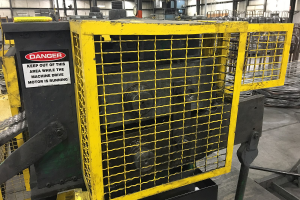Defining acceptable risk in LOTO or machine guarding
Safety professionals concerned with safety, efficiency and compliance should have the concepts of “acceptable risk” and “feasibility” in the forefront of their thinking. I have had numerous clients in the past couple of years confronted with OSHA citations and unworkable suggestions by the agency. In every case, the “acceptable risk” and “feasibility” of lockout/tagout or machine guarding was the central issue. I’m happy to report that the clients prevailed using the guidance of ANSI B11.
ANSI B11 is the series of general industry machine safety standards used by suppliers and users of machines. OSHA also makes significant reference to using B11 standards in a number of online references, two of which can be found here and here.
Both U.S. and international safety standards recognize that zero risk does not exist. Risk can be reduced or traded but not eliminated. ANSI B11.0 is an “A” level or foundation standard for the B11 family of general industry machine safety standards. It is harmonized with ISO machine safety standards. The foreword to ANSI B11.0 provides:
“Safety is the state of being protected from recognized hazards that are likely to cause physical harm. There is no such thing as being absolutely safe, that is, a complete absence of risk. In turn, there is no machine that is absolutely safe. All machinery contains hazards, and some level of residual risk. However, the risk associated with those hazards should be reduced to an acceptable level…”
In B11.0 we also find the definition for acceptable risk and an informative note that provides significant real-world guidance on ‘feasibility”:
“3.1 Acceptable risk: A risk level achieved after risk reduction measures have been applied. It is a risk level that is accepted for a given task (hazardous situation) or hazard. For the purpose of this standard, the terms ― acceptable risk and tolerable risk are considered to be synonymous.
“Informative Note 1: The expression “acceptable risk” usually, but not always, refers to the level at which further technologically, functionally and financially feasible risk reduction measures or additional expenditure of resources will not result in significant reduction in risk. The decision to accept (tolerate) a risk is influenced by many factors including the culture, technological and economic feasibility of installing additional risk reduction measures, the degree of protection achieved through the use of additional risk reduction measures, and the regulatory requirements or best industry practice.” (Note: Bold added for emphasis and clarity)
Hence, in the world of general industry machines, technology, functionality and financial issues are all part of “feasible risk reduction.”
If you are concerned with suggestions from OSHA or others that force workers to go around the system to do their jobs, I encourage you to do a task based risk assessment. That is the first step to determining feasible safeguards that provide acceptable risk.
If you have questions, please feel free to contact me.


